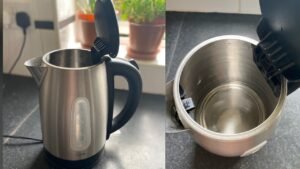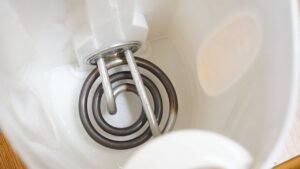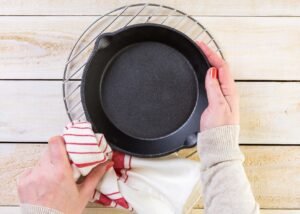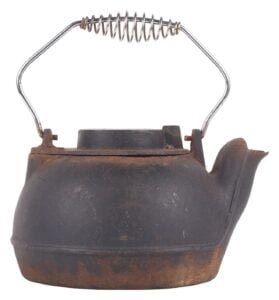There are many types of materials used in manufacturing cookware, from glass to aluminum or ceramic. Some are more affordable while others cost more because they bring a set of advantages that turn them into the most durable over time and safe for use for the entire family. Cast iron is one of the materials that can be easily considered an investment in your cookware. Tea lovers, in particular, choose a cast iron teapot since it not only ensures a tasty cup of tea, but it’s also a great decoration for their kitchen. In case you haven’t bought a cast iron tea kettle yet, you will surely buy one once you are aware of how great it is.

Is cast iron safe?
Cast iron has been used as a prime material in making kettles for centuries because it’s one of the most resistant materials ever discovered by man. It’s an alloy of iron and carbon, with great heating properties and a high durability due to its low melting temperature. While iron is actually soft and can be bent or broken with ease, adding the carbon makes it extremely lasting and hard. Aside from stone, it is the oldest most popular cooking surface that ensures great cooking results, but people fairly question whether or not it is a safe choice.
As you know, iron is very important in every body, as most cells contain it. A proper diet should bring you the necessary amount of iron to strengthen your health, since iron is found in many foods like red meat, seafood, spinach, or cereals. Getting enough iron from your diet will help you fight fatigue, enjoy a better focus and even fight colds due to a strong immune system.
As it happens at high temperatures, the iron released from a cast iron pot while cooking is then absorbed into our body, which is a good thing. While other substances, like polymers often found in cookware, should not find their way into our bodies, iron is quite safe because it’s one of the essential minerals we need for a strong health. Yes, the iron in your cooking pan can help you reach the right amount of iron in your diet, no matter how strange this might sound. Therefore, you shouldn’t worry that enjoying a cup of tea made in your favorite kettle made of cast iron is going to turn out dangerous for your health.

Best way to clean cast iron
Although it’s more demanding than the other resources, cast iron cookware is not impossible to maintain, but it does bring up certain serious matters. It’s important that you clean both the inside and the exterior of the pot, because rust can ruin it from both sides. If your pot has a nice ceramic finish, cleaning can be completed with a drop of dish soap and a soft fabric. Remember to avoid using detergents or dish soap on the interior of cast iron cooking pans. If the exterior is natural cast iron, you will have to pay the same attention as with the inside. The procedure applied during the cleaning process is also known as “seasoning” and although it sounds fancy and complicated, it’s actually very intuitive.
What does “seasoning” a cast iron pan mean?
When oil is heated inside a cast iron kettle or pan, the fat acids it contains reorganize in a chemical process and attach to the surface of the iron, producing a glossy non-stick layer that will contribute to the durability and cooking properties. This oily layer must be maintained over time so that moisture and rust will not attack and ruin the anti-adherent surface. Any type of oil will work, whether it’s sunflower, coconut, canola or almond. Whatsoever you can find in your pantry is good. You can heat the oil on the cooktop or in the oven if you are looking to achieve a thorough inside-out cleaning. Once the oil is heated to about 350 degrees, dispose of it, and then firmly wipe the exterior with a rubbing pad to ensure that the oil reaches the entire surface, leaving it slippery and non-stick.
Can I over season it?
Yes, there is such thing as over seasoning your cast iron, and the effect will be a greasy and sticky surface that will attract dust and grime. To avoid this, make sure you rub off the surplus oil until the surface results oily but not greasy. Test it with your finger and if it remains very oil, wipe off the surface one more time.
How do I tell if I well-seasoned my pots?
The most effective way to test the efficiency of your seasoning technique is touching the surface and inspecting it cautiously. It should be dark, with a silky aspect, but not overly greased or very shiny. It should not have dull or dry portions and the oil layer should not be very thick. Pans can be tested by the so-called “egg test”, which involves heating some oil on the bottom of the pan and adding an egg. If it cooks without sticking, it means you have seasoned it properly.

Cleaning kettles made of cast iron
The major problem with kettles is that they tend to rust over time, so you need to clean them thoroughly. However, there is a difference between cast iron skillets and the kettles, because the last ones do not require oil seasoning, since you are not looking for non-stick properties, but only a non-rust surface. Even the best cast iron kettle can be ruined if not cleaned properly, so ensure you certainly not skip this part. It’s true that a teapot it’s not as heavily used as a cooking pan or a skillet, but the kettle requires the same cleaning attention if you want to preserve it from rust and moisture. You can make use of the following most common 3 homemade solutions for keeping your kettles in the best shape.
1. Vinegar and water
Although it might appear strange, vinegar is an effective substance and it provides long-lasting results. This is something you will have to use more rarely and only when the level of damage of the rust is very high, particularly when it comes to antique kettles passed on from your grandma. Start by mixing equal parts of water and vinegar and allow the kettle to rest in this homemade solution for one to six hours, then softly clean it with a rubbing pad until all the corrosion is removed.
2. Tea leaves infusion
After you enjoy your tea, use the leftover leaves to clean the kettle. Boil them in water then leave them to sit for around 20 minutes, then toss away and let the kettle dry prior to storing it away.
3. Salt scrub
If you don’t have a brush at hand, you can always make your own scrub using regular salt that is naturally abrasive. Simply cover the bottom of the tea kettle with salt, leave it to absorb the moist and soil, then remove it using damp cloths. Salt also works for the exterior because it doesn’t scuff and ruin the appearance while cleaning. However, this is a technique that is only recommended when the metal is very rusty and should not be used as a common cleaning routine.
Aspects to take into account while cleaning a cast iron tea kettle
- Let the hot kettle cool down before cleaning it so that the metal will harden and it will not be sensitive to shocks. Only the exterior can be gently rubbed with a soft fabric while it’s still warm.
- Never use soap that can attack the cast iron in depth. Regular water will be just fine.
- Once your kettle is cleaned, it’s essential that you only store it after it has dried completely. Otherwise, it is prone to rusting, so your efforts of cleaning it will be in vain. Never cover it with the lid if you notice that the interior is still moist and never store it in a wet place that will favor the appearance of moisture.
- Scratching it with harsh rubbing pads is not going to be good for the kettle because it will create openings in the material where rust can easily penetrate. A brush with soft hairs is a much better option than steel wool, and ensures you apply a gentle pressure to avoid over-scratching.
- Don’t use the dishwasher; it’s best that you wash by hand the items made of cast iron.

Is it worth investing in cast iron dishware?
There are good and bad sides of everything we choose in our life, and it’s important that you know all of them before making a decision, so it’s helpful to find out which are the pros and cons of choosing cast iron kettles over other types.
The good
- A great design
Let’s be fair, sipping a cup of tea from an antique kettle made of cast iron is going to make you feel precious. The design is elegant, interesting and attractive, which is why many people even opt for this type of tea kettles as decorations only. These items come in a diversity of styles, shapes, even colors, with finishing touches that turn them into real pieces of decoration rather than a simple cookware.
- Durability
Among the most important aspects is that this type of kettle is going to last for ages. It doesn’t break fast, it doesn’t get worn out and it can be considered a vintage item that never goes out of style. However, you must take good care of it in order to enjoy its benefits to their fullest.
- They retain heat
Since cast iron is recognized for its thermal properties, it makes a great choice for teapots because it keeps the liquid hot for longer. The material conducts heat in a very effective way so that it works as a natural thermos that will keep your favorite herb infusion steaming hot till you are ready to enjoy it.
The bad
- Expensive
The biggest drawback of a cast iron teapot is its high price, compared to a kettle manufactured of aluminum or stainless steel. However, if you invest in the best cast iron kettle, you will see that it is a lifetime investment. Their prices can reach a few hundred dollars, but their durability and stylish design outcome this detail. Many generations have passed onto each other vintage kettles that haven’t lost their appearance nor their properties, so an item like this can be considered heritage.
- Demanding
As mentioned before, cast iron is not a regular material that you can wash with dishwashing detergent and put aside in a corner. It needs particular care and you have to take into consideration a few aspects that are going to contribute to the durability of this material. Cleaning and storage are the key aspects you need to pay consideration to.
Conclusion
With all the models out there, it’s hard to know exactly which kettle to go for. However, the cast iron ones manage to stand out from the crowd thanks to their appealing design and the great heating properties. Although a little more expensive and demanding when referring to maintenance, they will turn out to be a great investment that you will enjoy for a very long time. Therefore, don’t hesitate to use that old tea kettle you have at home or dare to invest in a high quality cast iron kettle that will improve the flavor of your favorite tea.